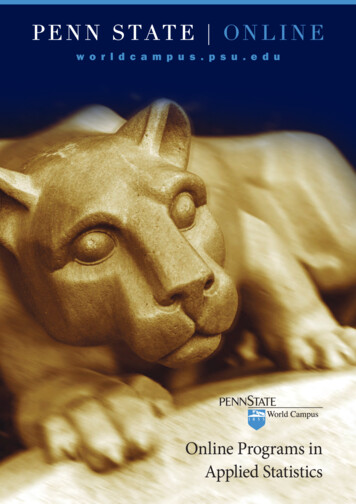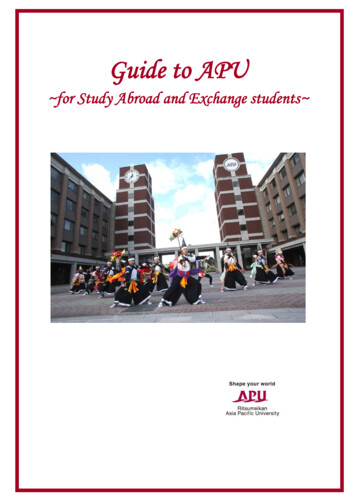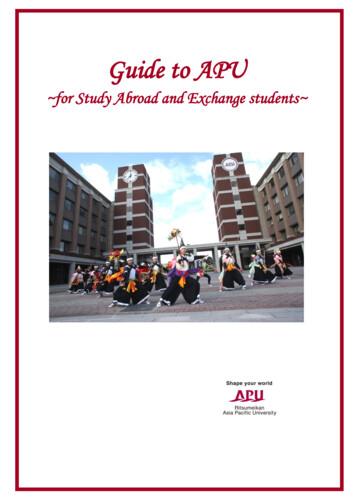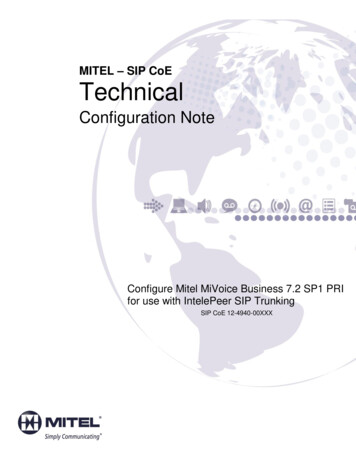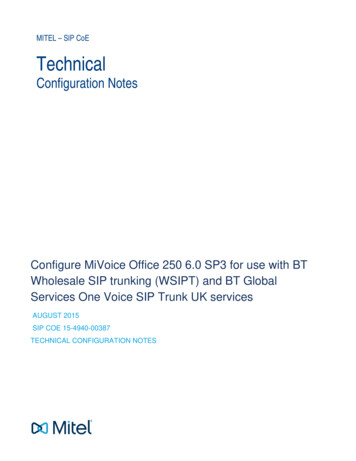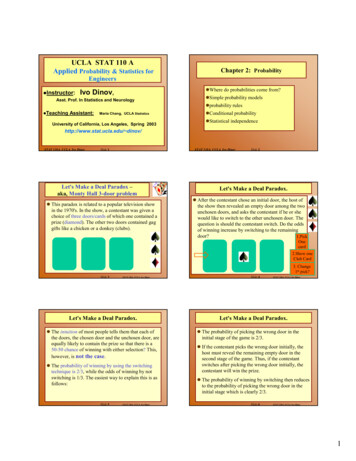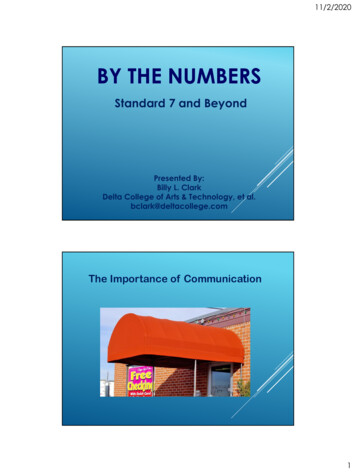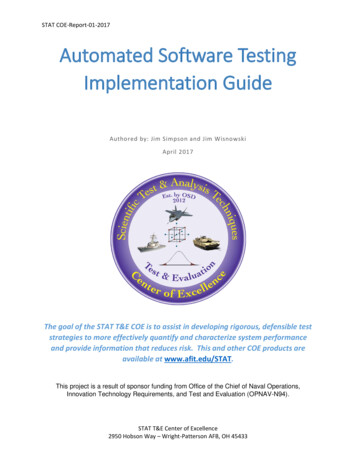
Transcription
STAT COE-Report-01-2017Automated Software TestingImplementation GuideAuthored by: Jim Simpson and Jim WisnowskiApril 2017The goal of the STAT T&E COE is to assist in developing rigorous, defensible teststrategies to more effectively quantify and characterize system performanceand provide information that reduces risk. This and other COE products areavailable at www.afit.edu/STAT.This project is a result of sponsor funding from Office of the Chief of Naval Operations,Innovation Technology Requirements, and Test and Evaluation (OPNAV-N94).STAT T&E Center of Excellence2950 Hobson Way – Wright-Patterson AFB, OH 45433
STAT COE-Report-01-2017Automated Software TestingImplementation GuidePage 2
STAT COE-Report-01-2017Contents1.Executive Overview . 5Use of the Guide . 62.Introduction . 73.Phase 0: Pre-Plan . 9Conduct Research on Test Program and Automated Software Test . 9Understand Your Environment . 10Assess Manpower and Skillset Requirements . 11Determine Potential Benefits from Automation . 11Quantify Costs of the Automation Effort . 12Decide Based on Expected Return on Investment. 124.Phase 1: Plan . 14Identify Automation Requirements . 14Develop DEF-based Requirements Prioritization. 15Identify and Compare Tools . 17Determine Automation Needs . 18Outline Test Scripts . 18Publish Automated Software Test Plan . 195.Phase 2: Design for Automation . 20Determine What to Automate . 20Select Tools . 20Build Automation Capability . 21Determine Automated Test Platform and Framework . 21Generate Scenarios and Test Cases . 22Determine Test Case Coverage . 23Decide Test Timing . 23Establish Data Acquisition and Processing Systems . 24Determine Approach to Test Oracle . 24Create Configuration Control Construct . 26Conduct Design Review. 266.Phase 3: Execute . 27Capture Operator’s Application of the System . 27Create Manual Tests . 27Page 3
STAT COE-Report-01-2017Decide Automated Test Environments . 27Integrate Tools within the Automated Test Framework . 28Develop and Refine Automation Scripts . 28Verify Automation Pilot Results . 28Execute the Automation . 28Execute Contingencies . 297.Phase 4: Analyze . 30Establish Data Output Format . 30Analyze SUT Anomalies . 30Summarize Requirements Tested and Identify Possible Voids. 31Check Repeatability and Reproducibility . 31Compute and Update Automation Metrics . 31Compute ROIs and Consider Future AST Program. 328.Phase 5: Maintain. 33Manage Automated Software Suite Configuration . 33Update Automation Code . 33Manage Scripts. 33Track Program Software Defects . 34Assess Defect Discovery Trends . 349.10.References . 35Appendix A: Acronym List . 37Page 4
STAT COE-Report-01-20171. Executive OverviewThis guide is intended to serve those in the Department of Defense (DoD) interested in applyingautomation to software testing. It applies a systems engineering process based on the scientific methodfor the steps to conduct and to achieve an automation capability along with the important need toperform a return on investment (ROI) analysis to make the business case for automation.Who is the intended reader? Some organizations are considering automation for the first time. For thataudience, we recommend executing all phases proposed in the implementation guide. Outsideassistance from groups with automation experience is a must. Seek their guidance and benefit fromtheir experiences. In addition, there is a wealth of guidance readily available in texts and online. Somesoftware acquisition programs have had some exposure to, or experience in automation and areinterested in improving one or more aspects of their automation process. Common objectives are toselect additional system functions or capabilities to automate, to secure more automators, or to changeor expand the tools used. For those groups, perhaps only a portion of the guide is applicable.The guide is organized around the phases of implementation listed below, which are intended toencompass the life cycle of automated software testing within your test program. Pre-plan – research, invest time, and gather information for making an informed decision onautomation. Perform a cost benefit analysis and compute an ROI, and be sure to include anylong-term benefits, then decide whether or not to automate. Specific steps include researchinto the program test plan, automation capabilities and opportunities, knowing manpowerskillset and resource needs, and quantifying costs and benefits from automation.Plan – develop an automated software test plan by identifying and prioritizing testrequirements, identifying and assessing appropriate automation tools with quantifiable anddiscernable metrics, identifying barriers to automation implementation, drafting the testautomation framework, and outlining the test script needs.Design – take the automation plan another level deeper in detail and make decisions for howbest to execute automation. In this phase, automation tools are selected and made available,test scenarios for automation are generated, test cases are determined, the output analysisstrategy is designed, and configuration control is established, all culminating in a design review.Execute – the activities and decisions that enable a test, otherwise to be conducted manually, tobe automated. It often starts by interviewing a system operator or capturing the manualtester’s steps, then decide the best automated test environment, integrate the tools within thedesigned test framework, develop and refine the automation scripts, and iteratively test out theexecution while refining the process.Analyze – the focus is on the output of each automated test, typically involving recording datafiles or log files. The purpose is to combine, manipulate, and analyze the output data to learnoutput errors and faults associated with the system under test (SUT) to include integrationissues. Individual steps include setting the data format, assessing the output data, ensuringanomalies are real and characterizing anomalies, revising automation metrics, and ROI.Maintain – this final phase is often the most time consuming and painful aspect of automation.Once test scripts have been written, executed, and refined for optimal use, something (SUT, thetest environment including monitors or operating system versions and IT patches, automationtool version, etc.) changes. The scripts now fail to execute properly unless revised, which is oneof the tasks in the maintenance phase.Page 5
STAT COE-Report-01-2017Although the phases can be visualized and enacted in a chronological or linear fashion, we realize andstress that there is significant connectivity between them such that moving in a less structured oriterative direction can be advisable. The suggested approach also involves maturing several importantautomation tasks across multiple phases. For example, automation tool selection is often considered aprimary and critical decision. This guide suggests tool selection and tool acquisition be a part of each ofthe plan, design, and execute phases, where increased knowledge and topic maturity is obtained insubsequent phases. Iteration and looping of the phases is a key to success.If time is restricted and an automation decision must be made quickly, along with short-turn preparationfor automation, be sure to at least consider the following: Research automation opportunities and learn which automation tools are best. Know the costs.Obtain leadership support by presenting the ROI and quickly identify the barriers to success.Learn which parts of your testing are best for automation, design the automation framework,and determine the suite of tools needed for your automation program.Find, hire, or grow the automation expertise. Growing can be easier than you think.Start with simple automation tasks and increase complexity as automation capability matures.Think carefully about how best to cover the input test space and how to get the most of theoutput from automated tests.Decide the automation frequency based on the software development cycle and testing needs.Understand that maintenance can be most costly and require the most resources.Use of the GuideA useful feature of the Implementation Guide is the frequent placement of summaries, or Bottom Lines,throughout to highlight various activities and concisely capture the essence of a step within a phase.One can use the find function within the document to quickly locate all the bottom lines, which canserve as a brief synopsis of the vital tasks to undertake when planning for or conducting software testautomation.Going forward, the intent is to distribute this guide widely and solicit feedback so that the guide can becontinually improved. New revisions will be made available, and will eventually be posted on anautomated software testing (AST) knowledge center website. It is also hoped that this guide and otherslike it (e.g. AST Practices and Pitfalls) may be of service to the AST community. Ultimately, we desire tosee improved communication and better collaboration among AST professionals and to connect likeminded people, projects, and interests.The material herein comes not only from published material including peer-review journal articles,conference material, and textbooks, but even more so from direct conversation with those of you in theDoD taking advantage of automation for testing software intensive systems. The Scientific Test andAnalysis Techniques Center of Excellence (STAT COE) is available to assist you as needed and can put youin touch with groups or experts willing to assist as you move towards automated software testing.Page 6
STAT COE-Report-01-20172. IntroductionAutomated Software Testing (AST) has had significant impact across the Department of Defense (DoD)and industry. The DoD has not taken full advantage of the efficiencies and improved performancepossible using automated approaches across the software development lifecycle. The failure to take fulladvantage of AST methods is connected to the DoD’s lack of understanding of the AST process. Thepurpose of this Implementation Guide is to provide management and practitioners a handbook thatoutlines a reusable framework to employ AST methods across a variety of DoD systems.This effort is part of the Office of the Secretary of Defense (OSD) Deputy Assistant Secretary of Defense,Developmental Test and Evaluation (DASD(DT&E)) STAT COE initiative to better educate programs onthe benefits of automated test. The purpose of this manual is to describe the general flow of an ASTprogram from end-to-end and provide insights to activities that will lead to a successful automationeffort. The guide describes detailed tasks within the six primary AST phases: pre-plan, plan, design,execute, analyze, and maintain. These phases allow programs to comply with the DoDI 5000.02(Enclosure 4, paragraph 5.a.(12)) requirements for a test automation strategy. These phases are notnecessarily sequential as Figure 1 shows. The activities for successful AST require an iterative approach.Pre-plan Assess environment, system, manpowerQuantify costs and benefits;Make Go/No-Go decision Configuration managementUpdate codeManage script repositoryTrack defects and assesstrendsEstablish data outputAnalyze anomaliesCheck repeatabilityUpdate metrics andcompute ROIsRefine AST solutionMaintainPlanAnalyzeDesignExecute Identify automationrequirementsPrioritize requirementsIdentify and compare toolsDetermine automationframework needsOutline test scriptsCreate test plan Select tools / test platformGenerate test scenariosDetermine test casesEstablish data processingCreate configuration controlConduct design review Create manual tests from users’ operational profilesDevelop and refine automation scriptsIntegrate tools within automated test suiteVerify automation with smaller test casesExecute test cases and scenarios and contingenciesFigure 1. Major phases and tasks for AST programsThe intended audience is leadership (both program and test), system engineers, software engineers,software developers, software testers, and test automators. The tasks are described at a general leveland technical details are explained from the vantage point of someone with little knowledge of softwaretest and automation. The AST process flow was developed primarily from interviews with experts acrossPage 7
STAT COE-Report-01-2017DoD and industry who have had success and failure automating test cases. Additional sources includeprevious DoD studies, textbooks, technical journals, websites, blogs, and conference briefings. Thoughevery program has unique experiences in the automation journey, there are many common elementsthat have formed the basis for this recommended methodology for DoD systems.Page 8
STAT COE-Report-01-20173. Phase 0: Pre-PlanAutomation can offer huge improvements in test efficiency and effectiveness but may requiresubstantial investment. Not all programs and requirements should be automated. Before launching intoan automated software test program, take the time to assess its value relative to the costs not only inthe short term, but especially in the long term. This ROI or business case analysis does not require highlyaccurate and precise estimates, but does require a sound systems engineering and decision analysisapproach. It is essential to have either an operations analyst with these skills and experience or to seekoutside assistance or counsel. A rough order of magnitude (ROM) ROI estimate is needed in this preplanning phase in order to make a ‘Go/No-Go’ decision to pursue automation.The Pre-Planning phase will require some time; studying the facets of automation and learning aboutautomation efforts performed on similar or related systems to better understand how the automatedtesting landscape applies to the specific system requirements. It will go considerably smoother if youhave personnel familiar with not only software testing but also automated software testing. If you donot have these resources, fortunately there are organizations across the DoD enterprise that are willingto help – often at no cost. This investment in understanding AST and how it pertains to your system willbe beneficial for the project team, particularly if the decision is to automate, but even if automation isnot the recommended direction.Conduct Research on Test Program and Automated Software TestThe first step to determining if an automated approach makes sense is to take the goals, objectives, andrequirements for the system under test and look for logical opportunities to apply automation. If youare in early unit testing, say developing software for components of a complex system, tests that wouldneed to be executed only once may not make sense to automate. Conversely, if the system undergoingsoftware development is further along, say undergoing integration testing with new capabilities addedrepetitively, automation may be tremendously helpful, especially for regression testing to ensure corefunctionality has not been impacted with the new updates. Many systems will not have access to thesoftware code so only black-box testing will be possible. Whether capable of white, gray, or black-boxtesting, not all software requirements are testable and of those that can be tested, not all should beautomated. Realize that the program documentation (e.g. Capabilities Development Document orSystem Requirements Document) of system and design requirements/specifications are key inputs, butmany other requirements exist and need to be tested based on the expected operational use andoperational environment.You should have team members with some familiarity with AST or at least have reasonable access toindividuals with these skills. Some useful resources for a background in AST include the Scientific Testand Analysis Techniques Center of Excellence (https://www.afit.edu/stat/), local organizations with ASTexpertise such as the SPAWAR Rapid Integration and Test Environment (RITE), commercial vendors (e.g.,http://www.idtus.com/; https://smartbear.com/; -functional-automated-testing/index.html), industry experts, and textbooks such asImplementing Automated Software Testing (Dustin et al.), Experiences of Test Automation (Graham andFewster), Introduction to Software Testing (Ammann & Offutt), Foundations of Software Testing(Mathur), and Software Testing (Hambling). Know there is a difference between automation and testing,Page 9
STAT COE-Report-01-2017and that automation supports testing. The goal is to understand AST at a high level, determine whattypes of testing can be successfully automated, and generally recognize the value of applyingautomation.An important aspect of your research is investigating what automation efforts have occurred (orpurposefully not occurred) on relevant systems, whether applied to previous versions of the system, orsubsystems, or to similar systems. Here it is essential to investigate broadly and aggressively acrossorganizations and across services. It is not uncommon for software development or acquisition teams(especially in larger programs and in the joint environment) to not have visibility into automation effortsin closely related programs. Where possible, try to leverage the previous and current automation work(tools and scripts) to quickly gain as much understanding as possible in order to inform the businessdecision to automate.The system software development contractor may be conducting AST internally either as a standardpractice or contractual requirement. Try to get visibility into what they have done or are doing andwhether you can obtain access to their automation work either through deliverables (i.e., Contract DataRequirement Lists or CDRLs) or by a site visit involving demonstrations and documentation.Bottom line: Conduct research into automation opportunities for your program. Find the right peoplethat can perform a technical assessment, learn about ongoing automation for similar programs, and findout what the contractor is doing with automation.Understand Your EnvironmentAutomation efforts have a better chance of success when there is not only sufficient capability but alsosupport across the organization. Automation in testing is not the typical mindset of most DoDorganizations. One theme across all organizations, government or commercial, is the essential role ofleadership championing AST and actively managing the process. Culture may be an important andpossibly insurmountable obstacle. If manual testing is the “way we always do it,” then a combination ofleadership, policy, and technical skill insertion is needed to move forward. AST is the cornerstone asprograms transition to a test-driven development (TDD) method with Agile and DevOps. Agile andDevOps also require culture change as software developers embrace change, operators desire stability,and testers focus on risk reduction.There should be a general understanding of the AST resources required in the current test environment.Examples include personnel (testers and automators), software/tools, host computers, networkenvironment, cloud support, information assurance/cyber protection, software approval processes,enterprise licensing, and so forth. It is essential to understand the overall schedule and flexibilitybecause it may not be possible to automate within the timelines.Bottom line: Pave the way to automation success by securing leadership support, identifying the majorpieces that must be in place in order to automate and then comparing the needed resources to yourprogram’s current state. Gain a sense for the hurdles to overcome in order to build an automationcapability.Page 10
STAT COE-Report-01-2017Assess Manpower and Skillset RequirementsThere often is a distinct difference in skillsets and experience between software testers and automators.With today’s tools, testers with little software development experience can effectively learn toautomate some aspects of testing otherwise done manually. However, a robust, streamlined,maintainable, and reusable automation solution often requires significant investment in software codingand development to grow fully independent and reusable automation test scripts that take fulladvantage of automation capabilities. Rarely will a single automation tool with a friendly graphical userinterface (GUI) be the sole solution for all the automation needs. A suite of tools, each for a differentpurpose (e.g., browser apps, tracking, unit testing, and continuous testing) with different capabilitiesintegrated into an automation framework, is often the recommended solution. Many tool vendorsmarket their products as not requiring any software development experience, but they succeed in manyways at automating only specific types of tests and have limitations on maintainability and reusability.There will be significant lead time to hire and/or train personnel to achieve initial automation capability.The time and resources will be a function of automation goals. Management has to decide whether togrow the current workforce internally or hire out the positions. For hiring new staff, they must identifywhere the talent resides, the best source (military, civil service, or contractor) and then quickly attractthe right people, understanding the delays associated with the hiring process. If the decision is to buildan AST capability by training the current workforce, it may be difficult to find the individuals with theright potential and motivation who can be freed up from their current duties enough to train and besuccessful. If this approach is taken, a deliberate training plan that identifies appropriate peers, mentors,coaches, and training timelines is crucial to success.The long-term benefit to the software acquisition program could be substantial or perhaps an unwiseinvestment depending on how much automation is value added, given the constraints of the systemrequirements that are testable, the timelines, and expected future efforts. An alternative may be tocontract out the work to an experienced AST group, whether government, contractor, or commercial. Adetailed discussion of specific knowledge, skills, and abilities is provided in Phase 2: Design forAutomation.Bottom line: Finding or training automators is the single most important investment by any groupinterested in successful automation. This aspect of the automation process also tends to take the mosttime and can be expensive depending on the route chosen. Consider all your options in obtaining theright number and experience levels for the project.Determine Potential Benefits from AutomationThe primary goal of automated software testing is to discover defects and opportunities for improvedperformance more quickly and thoroughly than otherwise would have been achieved using a manualapproach. Some metrics to consider when comparing fully manual versus some degree of automationare: Increased coverage for lines of code testedIncreased coverage of expected operational paths and use casesManpower savings over manual testing, especially for repetitive testing (e.g. regression)Ability to scale with multiple users and environments; perform high-load and boundary testingPage 11
STAT COE-Report-01-2017 Ability of test force to focus energies on high priority/high risk areasBetter output data for analysis and reportingHigher defect discovery rate through better coverage and/or freeing manual testing resourcesfor deeper exploratory testingGreater delivered software qualityShorter time to field systemContinuous testing to include overnight and weekendsReusability of automated scriptsBottom line: Now is the time to start building a spreadsheet for comparing various automationalternatives. Possible choices are: a) no automation, b) partial or phased automation capability, and c)complete automation where appropriate. Consider the short term and long term impacts of eachalternative and use quantifiable metrics such as the ones listed above.Quantify Costs of the Automation EffortThere are both direct and indirect costs associated with an automation project. Representative directcosts include: software licensing and training; hardware and middleware components for the automatedtest framework; cloud and network
Automated Software Testing Implementation Guide . Authored by: Jim Simpson and Jim Wisnowski . April 2017 . The goal of the STAT T&E COE is to assist in developing rigorous, defensible test strategies to more effectively quantify and characterize system performance and provide informatio

